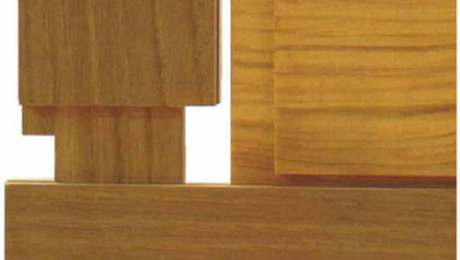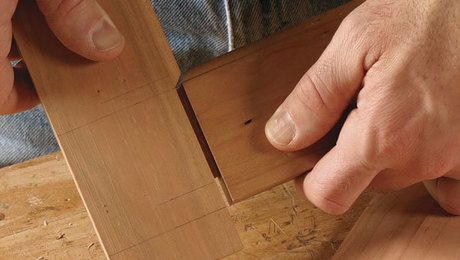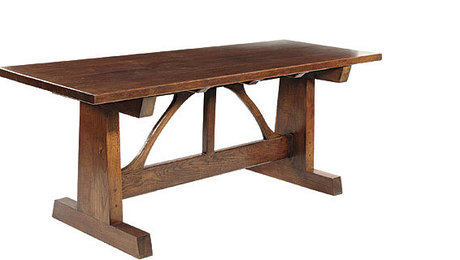STL209: Dealing with temperamental slabs
Anissa, Barry, and Ben laugh a lot while discussing frame and panels, backyard sawyers, working in shared shops, and what to do when a listener's partner isn't down with the A&C (Arts and Crafts).This episode is brought to you by:
Question 1:
From David:
I’m working on a maple writing desk, and I’d like to make a frame-and-panel drawer front out of solid wood.I have some concerns about wood movement. I’d like to maintain the reveal so a floating panel could be problematic. Should I attempt to pin it from the back of the frame in the center of the panel?
PS: Ben – I live in Nashville and also share your affinity for tacos from Nolensville rd. Good stuff.
 |
Frame-and-Panel CarcasesA classic solution for sound construction |
 |
|
Question 2:
From Tony:
I have recently embarked on my first slab project and it’s not going so well. My wife wanted a counter installed under our very picturesque 7 ft long dining room window so we can look dreamingly out of it as snow falls in our wooded back yard all winter. I convinced her that a live edge slab would be perfect! She was reluctant…
I bought a slab of red oak from a “backyard sawyer ”. He says the tree fell 4 years ago and the slab was cut a year ago and was stickered, covered, and left to air dry. At the time I did not have a moisture meter–I own one now. I brought the slab home and cut a couple of inches off each end. After about 20-hrs of it being in my basement shop the ends started checking and my wife was cursing me!
What can I do now? Why are slabs so temperamental? I love the look of live edges but how does one work with this stuff without checks and cracks?
 |
Success With Large SlabsFrom flattening to butterfly keys, how to handle one-of-a-kind pieces of wood |
 |
How to Add Strength and Style to Any SlabInlays transform a flawed slab into a sturdy work of art. |
 |
Level Big Slabs in No Time FlatNBC sitcom star, Nick Offerman, cooks up router jigs and Nakashima-style furniture in his L.A. shop |
 |
Dry Your Own LumberSave money and get a year’s worth of beautiful boards |
Segment: Smooth Move
Barry– Not realizing he was leaving a part off of a piece until he finished it. Even though he cut the part out.
Ben– Not realizing he was using a thin-kerf blade and a full-size splitter
Anissa–Not realizing that half-blind dovetails are supposed to be hidden
 |
Mitered Molding Simplifies Traditional DoorsPower tool technique works for any molding profile |
Question 3:
Two questions from Matt:
I have a large problem. I have become enamored with the arts and crafts style. Unfortunately, my wife hates every piece that I would like to build. Should I leave her? We have been married for 2 years, and I think I could live without her. Let me know what you think. Thanks!
 |
Uncommon Arts & Crafts |
Also from Matt:
I just finished my second project that incorporates hand cut joinery. I am working mostly in quarter sawn white oak. I find that when assembling my joints, I am busting the corners of my tails off. Is this common, or is there a fault with my technique? I rarely see photos that show the joinery well enough to determine if I am alone.
|
|
|
Question 4:
From Chris:
I am interested in building out a shop where I can work sporadically on the weeknights, and spend a bit more time on the weekends. I currently work in Biotechnology, so will more than likely always be working in big cities (Seattle, Boston, San Francisco) where space is limited. Based on that, is it smarter to make investments in hand tools, knowing the learning curve tends to be much steeper; or invest in shop time and do more assembly / finish type work at home?
Every two weeks, a team of Fine Woodworking staffers answers questions from readers on Shop Talk Live, Fine Woodworking‘s biweekly podcast. Send your woodworking questions to [email protected] for consideration in the regular broadcast! Our continued existence relies upon listener support. So if you enjoy the show, be sure to leave us a five-star rating and maybe even a nice comment on our iTunes page.























Comments
Someone needs to FOCUS!
Informative as always and holy crap, FUNNY episode!
Hay – larious, the only thing better would be, adding Bob Van Dike as a fourth, rubbing his face, herding cats.
Not much “Woodworking”, but literally, was Laughing out Loud.
Keep up the good work.
Oh my gosh that was a funny show!! I couldn't stop laughing.
Two things...
Annisa is always prepared, thoughtful in her comments, and her comments are base in knowledge about woodworking. She is a class act.
Slabs... wood does what wood does, perfectly, and aways exactly as wood is supposed to do. Our frustration with wood usually comes from hoping that for this project, the wood will do something differently than what the wood is going to perfectly do.
really enjoyed listening to this episode. Great job
As a woodmizer owner and "pole barn woodworker", I found the "basement woodworker" experience as frustrating as he did. A sawyer takes what is likely an oddly shaped and ready to crack log, and cuts it into the most/best stable and standard boards possible. Unless it is cut into a slab. A slab still has the oddness, desire to crack, move, warp, cup, twist.... that was in the log at the beginning. Every aspect of working with a slab is more difficult. It is a few less cuts at the mill, after that they are more work to move, stack, dry, surface... I hope he can eventually enjoy watching the snow fall.
Anissa and Barry have this great comedic delivery, and Ben is a great "straight-man." I also found their comments and suggestions useful, the balance between banter and wood shop worked very well.
The reason that most slabs misbehave is poor drying on the part of the sawyer. It takes more than a large saw mill to be a good sawyer. Drying is the most crucial part.
I was listening to this podcast while driving and had to pull over because I was laughing that much. Fantastic marital advice, you should start a new podcast just for that LOL. Well done guys keep it up.
Log in or create an account to post a comment.
Sign up Log in